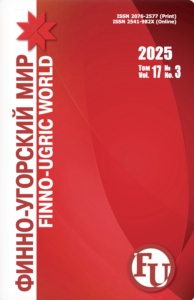DOI: 10.15507/2076-2577.012.2020.04.368-378
Valentina P. Grishunina,
Candidate Sc. {Philology}, Associate Professor, Department of Mordovian Languages, National Research Mordovia State University
(Saransk, Russia), grishunina.64@mail.ru
Natalia I. Ershova,
Candidate Sc. {Philology}, Associate Professor, Russian Language Department,
National Research Mordovia State University
(Saransk, Russia), tascha80@mail.ru
Introduction. The article presents the names of buildings and their parts presented in the subdialects of different districts of the Republic of Mordovia. The subject of the analysis is their gender-aspect relations, and certain features of their functioning. The goal of the research is to present the structural-semantic characteristics of dialect names of buildings and their parts in the subdialects of Mordovia.
Materials and Methods. To achieve this goal, various research methods are used, with the descriptive method as the main one. In addition, it uses the elements of the method of linguistic experiment, distributive and component analysis. The language material is dialect lexemes (lexical items) with the meaning of residential buildings and their parts, selected by continuous sampling from the Dictionary of Russian subdialects on the territory of the Republic of Mordovia.
Results and Discussion. As a result of the analysis of dialect material, it found that the lexical-semantic group “Names of buildings and their parts” includes nouns and has a hierarchical structure organized by semantic relations of hyperonyms that organize its structure. Buildings along with other items of material culture (clothing, food, tools) are an important source of information about everyday life and human activities, and they are important and ancient components of the material culture of any ethnic group. The corresponding dialect names that function in the subdialects of the Republic of Mordovia are characterized by exceptional richness and numerosity and differ from the corresponding lexemes of the literary language in greater detail related to the material for manufacturing, size, and purpose of buildings. This phenomenon is also observed on the territories of Mordovia (Moksha and Erzya), adjacent to Russian dialect speakers.
Conclusion. The research is of practical importance; the results can be used in writing of study guides on Russian dialectology, for University courses such as “Russian dialectology”, “Dialectology of the Moksha language”, “Dialectology of the Erzya language” and corresponding courses for students of degree programmes in Arts and Humanities.
Key words: noun; gender-aspect relations; hyperonym; hyperseme; meaning; subdialects; Russian dialectology; Moksha dialectology; Erzya dialectology; building.
For citation: Grishunina VP, Ershova NI. Structural-semantic features of buildings names and their parts in the subdialects of the republic of mordovia. Finno-ugorskii mir = Finno-Ugric World. 2020; 12; 4: 368–378. (In Russian)






















